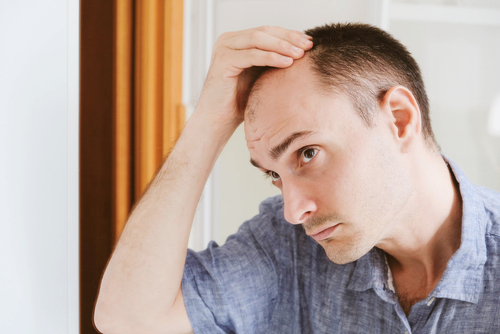Let’s face it—thinning hair is one of those things guys will go years without talking about, let alone treating.
In many cases, men aren’t willing to address the issue until it turns into full-blown baldness.
There’s good news though: for most guys, treating hair loss can be as easy as taking a pill once a day.
Finasteride is an effective, commonly prescribed medication that can help to reverse hair loss and grow new hair.
In this article, we outline everything you need to know about how this FDA-approved pill helps men achieve thicker hair, and whether it might be right for you.
Summary
Finasteride is an FDA-approved hair loss treatment for androgenetic alopecia, also known as male pattern baldness.
By slowing down the conversion of testosterone to DHT (dihydrotestosterone, also known as the "hair loss hormone"), finasteride can slow hair loss and help hair to regrow.
Men usually start seeing an improvement in their hair growth about three to four months after taking finasteride.
Finasteride requires a prescription from a licensed medical professional.
What Is Finasteride?
Finasteride is the generic name for the only oral medication ever approved by the FDA for the treatment of male androgenetic alopecia, commonly known as male pattern baldness.
In 1992, finasteride was originally approved under the brand names Propecia® and Proscar®.
It was prescribed as a treatment for benign prostatic hyperplasia, which is a non-cancerous condition where the prostate gland becomes enlarged.
Now prescribed under a variety of generic brand names, finasteride 1 mg is a once-daily pill that changes how your follicles react to the “hair loss hormone” dihydrotestosterone (DHT).
When finasteride was first approved for male pattern hair loss, it was a pretty exciting advancement.
Hair regrowth treatments were limited, and even today there are only two medications that the FDA actually approve: finasteride and minoxidil.
Now, you may be wondering how to get finasteride prescribed.
While topical minoxidil is applied to your scalp and is available over-the-counter, finasteride is a prescription medication that you won’t be able to access without a doctor’s order.
Let’s take a closer look at the reasons for this in the section below.

How Does Finasteride Work?
To understand how finasteride works, you’ll need to understand a bit more about the hair loss process.
One of the major contributing factors to hair loss in both men and women is an androgen hormone called dihydrotestosterone (DHT).
DHT is naturally occurring and necessary; like testosterone, DHT contributes to:
- A deeper voice in men.
- The development of more body hair and muscle mass.
- Proper sex organ development and function.
Women have DHT and testosterone in their bodies, too, just not as much. As DHT travels through the body, it attaches itself to receptors on hair follicles.
When we’re young, this has no major effect on hair growth.
However, as we age, those of us who are susceptible to DHT—based on our genetics—begin to see DHT negatively impact hair follicles.
The follicles begin to shrink and lose their once-effective hair-growing abilities. Not only does the hair follicle become thinner, weaker, and shorter, but it also grows more slowly.
Although this is a gradual process that gets worse over time, some people are more susceptible to DHT’s effects earlier on in life.
For some men, thinning begins in their 30s or even their 20s, while women often don’t see the effects of hair loss until later in life—often during menopause.
What’s the Link Between DHT, Finasteride, and Hair Loss?
As mentioned above, DHT is a derivative of testosterone. In men, about 10% of the testosterone in their bodies will be converted to DHT.
And how testosterone gets converted to dihydrotestosterone is where finasteride’s powerful capabilities come from.
Testosterone is converted to DHT by the 5-alpha-reductase (5AR) enzyme. This is a protein that’s also natural and present in everyone’s body.
This conversion happens all the time, and it’s the only way that DHT occurs in the body. This means that when there is no 5AR available, there can be no DHT.
The drug finasteride is a 5AR inhibitor that can lower blood DHT levels by as much as 80% in men.
Once it’s in the body, it counteracts the effects of 5AR—so less testosterone is synthesized into DHT.
When DHT levels decrease, there’s less of it in the body to negatively affect the hair’s follicles.
Does Finasteride Actually Regrow Hair?
Taken as a once-daily 1mg tablet, oral finasteride has shown an impressive ability to treat hair loss and help men regrow their hair.
Here’s What the Science Says
A few clinical trials in particular looked at the effect of finasteride on men with vertex baldness—a severe loss of hair from the crown of the head. More studies have been done, but these are some of the earliest and most well-known.
After six and 12-month intervals, the researchers saw a significant increase in the hair count of men treated with finasteride tablets.
At the same time, men who were treated with a placebo continued to see significant hair loss from the baseline they measured at the beginning of the trial.
One way that researchers measure hair loss and hair growth is by actually counting scalp hairs on men’s heads.
Compared to the placebo group, the men treated with finasteride saw a 107-hair difference in a 1-inch diameter circle.
Men who took finasteride for up to two years maintained that hair density and count, resulting in a 138-hair difference between treatment groups within the same area.
The men who were given finasteride saw the most improvement in their hair count (compared to their baseline) during the first two years of treatment.
Because the placebo group’s hair count continued to decline, the difference between treatment groups continued to increase throughout the two studies.
After five years, this resulted in a 277-hair difference between men who took finasteride and men who took the placebo.
Another study of finasteride looked at men with balding around the anterior of the scalp area.
In their assessments of the study, both the investigators and the patients found that finasteride provided enough regrowth to increase hair count.
So, can finasteride regrow hair?
The research shows that finasteride can help men grow new hair and slow or stop hair loss. Men who take it consistently have reported seeing improvements even five years later.
Can Finasteride Treat All Types of Hair Loss?
Finasteride is currently approved by the FDA to treat male pattern baldness.
Although this condition is the most common, there are over 100 different types of hair loss. Some of these include:
Alopecia Areata
This is an autoimmune disease where the hair falls out in small and round patches. Over time, this may lead to complete loss of hair on the head, eyebrows, and body.
Researchers aren’t exactly sure what causes alopecia areata, but there is a consensus that it occurs when the body’s immune system attacks hair follicles.
It’s thought that this condition may be related to stress, bacterial infections, or certain types of medications.
Telogen Effluvium
This condition is widely considered the second most common type of hair loss after male pattern baldness.
Telogen effluvium is usually brought on by medical conditions like a thyroid imbalance, prolonged fever, vitamin deficiencies, or extreme stress.
Although there is currently no cure for telogen effluvium, it usually goes away when the medical condition causing it is treated.
Lichen Planus
This is another autoimmune condition that results in the body attacking its skin cells, including those on the scalp.
This leads to follicles becoming damaged and the hair thinning or falling out.
Lichen planus is thought to be made worse by some medications for heart disease or high blood pressure, hepatitis infections, or certain pain relievers.
Does finasteride treat these conditions?
The types of hair loss mentioned above are caused by autoimmune and medical conditions—not DHT.
This means that finasteride won’t likely be effective for managing or reversing the hair loss associated with these conditions.
How Long Does Finasteride Take to Show Results?
When you start taking finasteride, it’s important to adopt a long-term mindset—instead of hoping to see results right away.
Although finasteride starts regulating DHT levels as soon as it enters the body, remember that hair growth takes time.
Generally, men start seeing a noticeable improvement about three to four months after taking finasteride.
If you don’t see any improvement after six months, speak to your doctor about your unique condition.
Men who do see results from finasteride will have to continue taking it every day to prevent further hair loss.
If you stop using finasteride, the body will start producing DHT in more volume. Without anything to slow this process down, you will likely start losing your hair again.
Is Finasteride Safe?
Like most pharmaceutical and prescription-grade medications, finasteride does have some adverse effects you should be aware of—particularly because it impacts hormone levels.
Women are generally advised not to take finasteride.
One small study found that finasteride was not effective in postmenopausal women after 12 months, compared to a placebo group.
Doctors also warn women who may become pregnant not to use finasteride.
This is because the 5AR inhibitor could interfere with the sexual development of the fetus and result in birth abnormalities.
The finasteride FDA label includes a warning about an increased risk of high-grade prostate cancer for some men who take finasteride 1 mg.
Across the studies of finasteride, there are a few side effects that occur more frequently in men taking finasteride than men in placebo groups. These side effects include:
- Decreased libido.
- Decreased volume of ejaculate.
- Breast enlargement (also known as gynecomastia).
- Breast tenderness.
- Erectile dysfunction.
- Ejaculation disorders.
- Dizziness.
- Runny nose.
- Skin rash.
- Weakness.
- Faintness.
Reverse Hair Loss and Restore Your Hair Today
Finasteride is a powerful treatment that prevents hair loss and helps men to regrow their hair.
Because it’s proven to work and has been around for so long, physicians are often comfortable with its use and prescribing it, too.
At Shapiro MD, our board-certified physicians can help men and women access prescription hair loss medications—like finasteride and even custom formulas —from the comfort of home.
We also offer highly-effective over-the-counter treatments—from shampoos and conditioners to oral supplements and comprehensive growth kits—to help you repair and regrow hair.
Our hair loss formulas are blended with some of the most effective natural ingredients for hair loss.
By combining nourishing natural compounds with modern medicine, we’ve created products that yield exceptional results.
To get started and find out how to get the results you want, take our free hair quiz today.




